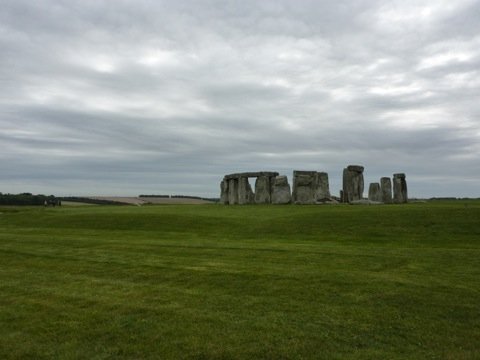A few months ago I looked at some visions of how aerial warfare might improve the city by blowing away ugly developments. Here's a similar fantasy of better planning through bombing, though the site in question is a rather surprising one: Stonehenge. From Clough Williams-Ellis's diatribe against the debeautification of the countryside, England and the Octopus (Portmeirion, 1975 [1928]), 130-1:
It is also to be hoped that some regard may be paid to pre-existing land-lubber amenities in the actual placing of aerodromes, and that the Stonehenge scandal will not be repeated. There, with all Salisbury Plain to choose from, the R.F.C. (as it then was) elected to plump down its hangars and all their sprawling appurtenances within a few hundred yards of what should be the most hallowed stones in England. Never were venerable remains less venerated, for at this very moment of writing, our late enemies having declined our military invitation to obliterate the circle with their bombs, an offensive pink bungalow is being completed hard by that, with the outrageous café adjoining, makes one almost pray for a destructive air raid.
As it now is, Stonehenge is intolerable, and by no means to be visited save by blind archæologists. Hemmed in by iron railings, guarded by a turnstile and a post-card kiosk, glowered at by the derelict aerodrome and smirked at by café and bungalow, this sacred place is indeed painful beyond bearing. If it were an even chance that a hostile air raid would destroy the circle or, alternatively, obliterate the parasitic growths about it, there are probably those who would favour the place being well and truly bombed.
As it is, Stonehenge is a mockery and a wounding of the spirit, and a fifty-fifty risk of losing it altogether or getting it back once more in its austere and immemorial loneliness might well seem a gamble worth considering.
I can't believe Williams-Ellis was actually serious: no matter how ugly Stonehenge's surrounds, surely he must have seen that they could be pulled down at some future date without having to rain bombs on the site. He's just trying to shock his readers into thinking, yes, Stonehenge really is pretty awful at the moment, maybe we should do something about it. In fact, by mid-1927 the Stonehenge Protection Committee and the National Trust had already raised enough funds to buy much of the surrounding area, as Williams-Ellis must have been aware.
But what about that aerodrome? Yes, there was indeed an aerodrome at Stonehenge, which after all is (and was) near a major Army training area. According to this Q&A page at the Centre for First World War Studies at the University of Birmingham, Stonehenge aerodrome (I'm not sure if that was its proper name) was in use between 1917 and 1921, initially for the training of bomber squadrons, including some which used big Handley Page O/400s. At various times it was home to No.1 School of Aerial Navigation and Bomb Dropping and the School of Army Cooperation. The buildings were not demolished until 1929.
And the aerodrome was very close to Stonehenge. Wiltshire County Council has a description of the aerodrome site and a map, which I've used to make the below. So it was a bit under a kilometre away, straddling the current position of the A303 which is the current blight on Stonehenge's landscape.
I wonder if there were any close encounters between Stonehenge and a bomber? (The photo at the top, from Wiltshire County Council, may well be a composite, and from the design of the aeroplane dates to well before the construction of the aerodrome.) One snippet I found on the web suggests that the RFC may have thought Stonehenge was a flight hazard, since it supposedly recommended that it be demolished. I find that very hard to believe, even aside from the fact that the source for this is a desk calendar by way of a blog, but if it is true then we may be thankful that wiser heads decided that the war against Germany could be won without such extreme measures being necessary.
![]() This work is licensed under a Creative Commons Attribution-NonCommercial-NoDerivatives 4.0 International License.
Permissions beyond the scope of this license may be available at http://airminded.org/copyright/.
This work is licensed under a Creative Commons Attribution-NonCommercial-NoDerivatives 4.0 International License.
Permissions beyond the scope of this license may be available at http://airminded.org/copyright/.





Ian Evans
I have a vague feeling (acute unreliability warning) that I read of this in some memoirs many years ago, but it wasn't an official proposal, more a matter of bored pilots enlivening a quiet night in the mess.
But there are people who want to demolish Stonehenge - check this -
http://johnmurraypenfold.20m.com/stonehenge.htm
Brett Holman
Post authorWow. That's pretty loopy!
There's nothing about that paragraph I don't like. Pure comedy gold.
Pingback:
Airminded · Friday, 3 January 1941
Tim Brown
There was certainly an airfield at Larkhill, a short distance to the NE of Stonehenge. The aerodrome was active from 1910-1914 and often referred to in contemporary publications (e.g. 'Flight' magazine) as 'Salisbury Plain Aerodrome'. Larkhill was used for some of the earliest flights in the UK, and home of the Bristol Aeroplane Company's Flying School where civilian and military pilots learnt to fly. There is little remaining of the airfield now, a couple of hangars still standing are I believe listed buildings? One thing's certain, it is not at the location shown on your photograph... which if correct must relate to another airfield, although my own researches have not yet revealed anything in that position?
Brett Holman
Post authorInteresting, I hadn't heard of the Larkhill aerodrome before. But it's definitely not the Stonehenge one. Wiltshire County Council's database has separate entries for each: Stonehenge Aerodrome here, and Larkhill Camp here. There's nothing left of the former, but as you say there are still hangars at Larkhill (actually Strangways, you can see them in Google Maps street view), still owned and used by the Army in fact. The database entry says these are 'probably the oldest aeronautical buildings in existance'. Not sure about that, but they must be close to it.
Tim Brown
Thanks Brett, a little more digging (and a bit of deeper googling) and I have found the following on the English Heritage site...
'A First World War military airfield, built in 1917 and closed in 1921. It was used by units of the Royal Navy Air Service and the Royal Air Force as a training base for day and night bombing. Training continued at Stonehenge until 1919 and in 1920 the site was briefly opened again by the School of Army Co-operation until 1921. During 1944 the airfield may have been briefly used by aircraft attached to the American 29th Infantry division, but this is uncertain.
The First World War airfield was constructed to the south-west of Stonehenge. The extensive 320 acre site was made up of a complex of buildings and roads that can be seen on aerial photographs of the early 1920s. The site was split into a Technical area and a Domestic area. The Technical area contained six coupled General Service (GS) Aeroplane sheds, General Repair Sheds, numerous huts for workshops, Bessonneau hangars, two Handley Page aircraft sheds as well as fuel storage tanks. The Domestic area was used to house the off duty air crews and consisted of various messes and a large barracks area of tents and huts.
Photographs taken in 1934 show that the complex was dismantled by that date, and on photographs taken in 1943 the aerodrome is only visible as earthwork remains. Traces of the site can still be seen as cropmarks on aerial photographs taken in 2001"
(Rod Priddle's book, 'Wings Over Wiltshire' apparently contains a detailed account of the history of the airfield.. I am waiting for my local library to get a copy for me)
Brett Holman
Post authorEnglish Heritage links to old-maps.co.uk which has a 1924 map of the (now former) aerodrome site. You can see Stonehenge in the upper right corner. The aerodrome both dwarfs Stonehenge and is very close to it -- only about 4 or 5 times its diameter away -- and that doesn't show the where the runways were either. Madness!
Charles Hoby
If you are interested I have an enormously long photograph of all the personnel of the navigation school taken outside of the navigation school. The legend states "No1 School of Navigation and Bomb Dropping Stonehenge March 1919"
Regards.
CH
Stuart hollburn-thorburn
I would be interested in seeing the photo Charles Hoby, if you look at Pathe news and type in demolition of Stonehenge airfield a short silent film from 1929 shows it being done
Susannah Walker
There's an English Heritage report about the Stonehenge airfield if you are interested: https://research.historicengland.org.uk/Report.aspx?i=15239
Brett Holman
Post authorSusannah:
Thanks!
Seamus Hamill-Keays
I was much taken by your article 'The Dragon Will Always Get Through' and then your book . You may find this article of some relevance particularly the inclusion of Tolkien's Letter 92 to his second son Christopher who had joined the RAF:
https://scholar.valpo.edu/journaloftolkienresearch/vol11/iss1/1
Brett Holman
Post authorThanks so much for alerting me to your excellent article! It adds so much necessary context to our understanding of what Tolkien was doing in while back in England after his frontline service. I (along with most of his biographers, it seems) assumed he was simply convalescing, but you show that he was (also) posted to various home defence units and, almost certainly, was at least very familiar with the raid warning system (including the Kilnsea acoustic mirror!) This is great stuff, and I think strengthens my argument that at some level, Smaug came out of Tolkien's experiences of air raids in the First World War. Thanks again.
Pingback:
Gang Roundup - January 2018
Neil Howlett
Coming late to this and incompletely there is a podcast about the modern history of Stonehenge, the airfield and how it was acquired. I recall it claimed that the site of the first fatal military aircraft crash is now under the new visitor centre. I'll try to re-find it. In the meantime this is lovely, and suggests the airfield was on what is now the pig farm south of the A303.
Brett Holman
Post authorThanks, Neil. Sounds like this crashon 5 July 1912, said to be the first operational RFC deaths? The memorial is just outside the visitor's centre.